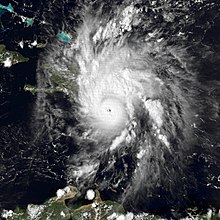 Emily at peak intensity near landfall on the island of Hispaniola on September 22 | |
| Meteorological history | |
|---|---|
| Formed | September 20, 1987 |
| Dissipated | September 26, 1987 |
| Category 3 major hurricane | |
| 1-minute sustained (SSHWS/NWS) | |
| Highest winds | 125 mph (205 km/h) |
| Lowest pressure | 958 mbar (hPa); 28.29 inHg |
| Overall effects | |
| Fatalities | 3 |
| Damage | $80.3 million (1987 USD) |
| Areas affected | Lesser Antilles, Hispaniola, Bahamas, Bermuda |
| IBTrACS | |
Part of the 1987 Atlantic hurricane season | |
Hurricane Emily was a powerful tropical cyclone that struck Hispaniola in September 1987. It was the first hurricane in the Caribbean Sea since Hurricane Katrina of 1981 and had the second-fastest forward speed of a 20th-century hurricane, behind only the 1938 New England hurricane. The twelfth tropical cyclone, fifth named storm, second hurricane, and only major hurricane to develop during the below-average 1987 Atlantic hurricane season, Emily formed out of a tropical disturbance that moved off the west coast of Africa on September 20, the storm quickly attained hurricane status before undergoing rapid intensification. On September 22. The storm attained its peak intensity with winds of 125 mph (201 km/h) and a barometric pressure of 958 mbar (hPa; 28.29 inHg) later that day. The storm weakened to Category 2 status before making landfall in the Dominican Republic. After weakening to a tropical storm, Emily rapidly tracked northeastward through the Atlantic Ocean, undergoing a second phase of rapid intensification before passing directly over Bermuda on September 25. The following day the final public advisory from the National Hurricane Center was issued on the storm as it transitioned into an extratropical cyclone.
Hurricane Emily brought heavy rains and strong winds in the Windward Islands on September 21, leaving numerous homes damaged and severe losses in the banana industry. Losses throughout the islands amounted to $291,000. In the Dominican Republic, despite the storm's high intensity, relatively moderate damage occurred. Three people were killed by the storm and damages amounted to $30 million. Unexpected intensification of the storm led to severe impact in Bermuda. Overall, the storm caused over $80 million in damages, killed 3, and injured 16 people.